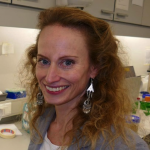Vivi Heine
Associate Professor
Although a glial component in neurological disorders is increasingly appreciated, we still lack proper understanding of neuron-glia communications. Our goal is to identify and describe glial defects in neurodevelopmental disorders, and to perform proof-of-concept studies for glial-targeted therapy strategies using advanced stem cell technologies.
Key publications
Dooves S, Kok LML, Holmes DB, Breeuwsma N, Breur M, Bugiani M, Wolf NI, Heine VM. Cortical interneuron development is affected in 4H leukodystrophy. Brain. 2023 Jul 3;146(7):2846-2860
Varderidou-Minasian S*, Hinz L*, Hagemans D, Posthuma D, Altelaar M, Heine VM. Quantitative proteomic analysis of Rett iPSC-derived neuronal progenitors. Mol Autism. 2020 May 27;11(1):38
Leferink P*, Dooves S*, Hillen AEJ*, Watanabe K, Jacobs G, Gasparotto L, Cornelissen-Steijger P, Van der Knaap MS, Heine VM. Astrocyte subtype vulnerability in stem cell models of Vanishing White Matter. Ann Neurol, 2019
Dooves S, Leferink PS, Krabbenborg S, Breeuwsma N, Bots S, Hillen AEJ, Jacobs G, Van der Knaap MS, Heine VM. Cell replacement therapy improves pathological hallmarks in a mouse model of leukodystrophy Vanishing White Matter. Stem Cell Reports, 2019.
Nadadhur AG, Alsaqati M, Gasparotto L, Cornelissen-Steijger P, van Hugte E, Dooves S, Harwood AJ, Heine VM. Neuron-Glia Interactions Increase Neuronal Phenotypes in Tuberous Sclerosis Complex Patient iPSC-Derived Models. Stem Cell Reports. 2019 Jan 8;12(1):42-56.
Falk A, Heine VM, Harwood AJ, Sullivan PF, Peitz M, Brüstle O, Shen S, Sun YM, Glover JC, Posthuma D, Djurovic S. Modeling psychiatric disorders: from genomic findings to cellular phenotypes. Mol Psychiatry. 2016 Sep;21(9):1321.
Glial Defects in Neurological Disorders
More and more evidence shows that glial cells are essential in proper neuronal functioning in the brain, like axonal conduction and synaptic transmission. The two major glial cell types in the brain are the oligodendrocytes and the astrocytes. The oligodendrocytes are responsible for myelin formation in the central neural system and astrocytes have homeostatic functions including synaptic and metabolic functions. The communication between neurons and glia involves signals like ion fluxes, neurotransmitters, growth factors and calcium. By regulating these signaling factors, glial cells can affect neuronal activity locally as well as on network level. Already during neurodevelopment, astrocytes have instructive influences on for example neuronal migration, distribution of synaptic connections and formation of myelinated axons, while oligodendrocytes regulate proper axonal transport, axonal diameter and microtubule number and stability. Since glial dysfunction is increasingly appreciated in neurological disorders, they might be target in future therapies.
Induced Pluripotent Stem Cell (iPSC) Technology
iPSC technology gives the opportunity to generate early stem cells from somatic cell types (incl. skin, hair, blood), and to generate patient-derived and disease-specific neural cell types of interest. This discovery opened new avenues to model diseases, where the genetic components have yet to be identified, or for which animal models are inappropriate. We use up-to-date and optimized procedures to generate patient iPSCs and iPSC-derived astrocytes, oligodendrocytes, microglia and neurons as well as brain organoids. The cultures are functionally analyzed in collaboration with on-side laboratories with state-of-the-art expertise in advanced microscopy, electrophysiology, proteomics and high content cellular screening. These efforts created the base for the VU/VUmc iPSCenter with the goal to improve current and to develop new treatment options for a variety of brain disorders. iPSC technology hold great promises for high-throughput screening platforms and cell replacement therapies for the future.

Ongoing Research
A better understanding of human cellular defects in (brain) disease: Much of our understanding of the functioning of the brain is based on research in rodent models. Nowadays iPSC technology allows us to study human developmental processes in more detail. The Stem Cell lab focuses on understanding human neuron-glia interactions and glial contributions to neurodevelopmental and neuropsychiatric disorders. Current projects involve generation and analysis of iPSCs from patients with the neurodevelopmental disorders Rett Syndrome, Tuberous Sclerosis Complex and Schizophrenia, and the leukodystrophies Vanishing White Matter, 4H leukodystrophy and adrenoleukodystrophy. In collaboration we develop new iPSC-based model systems to study e.g. myelination processes and Tau pathology in humans